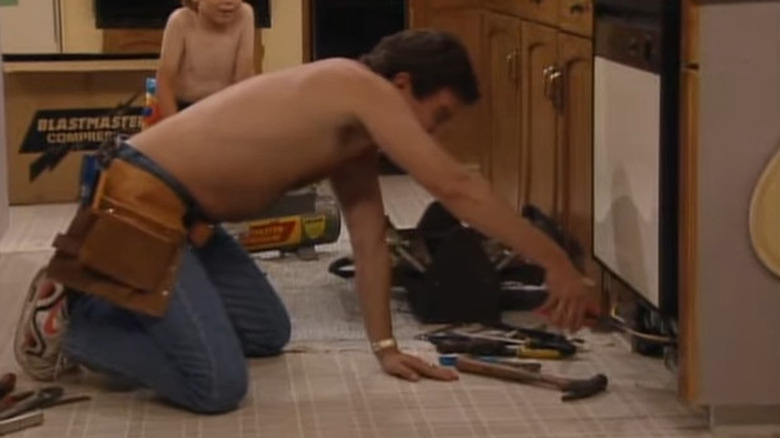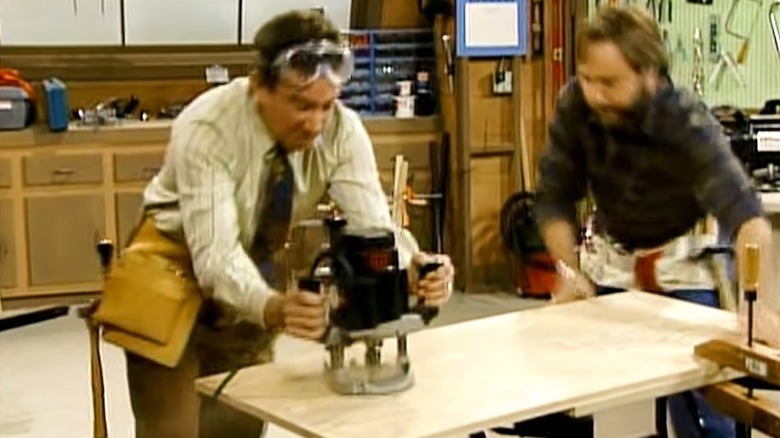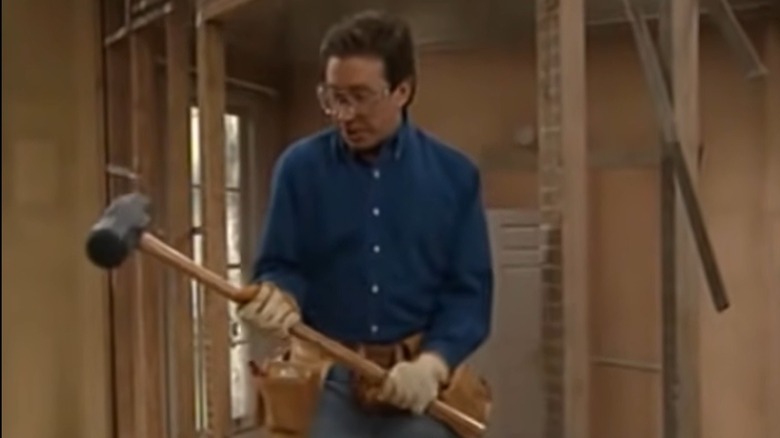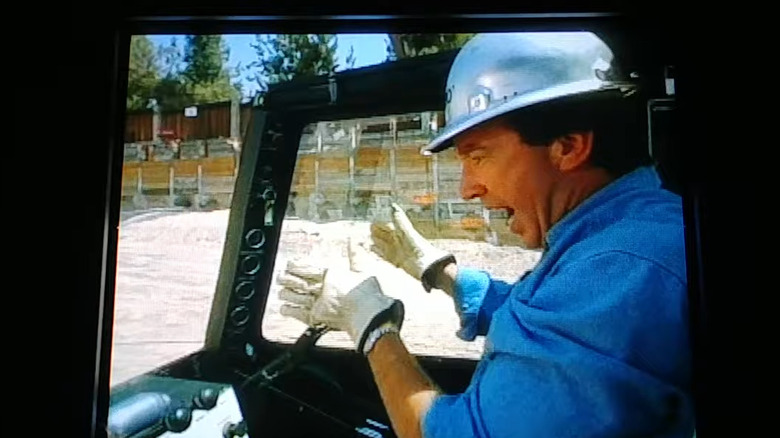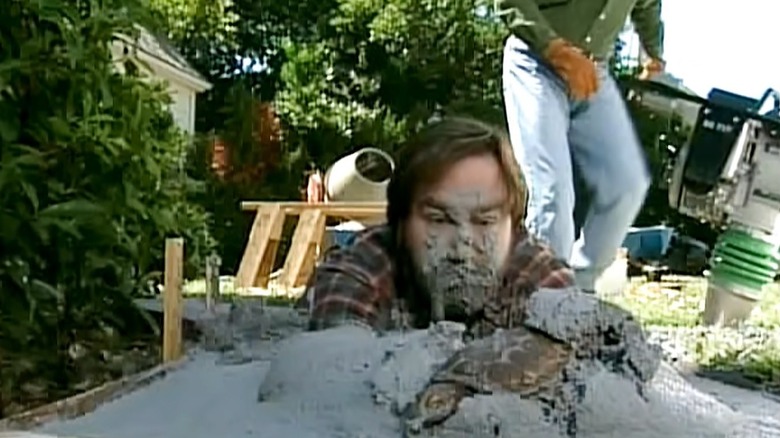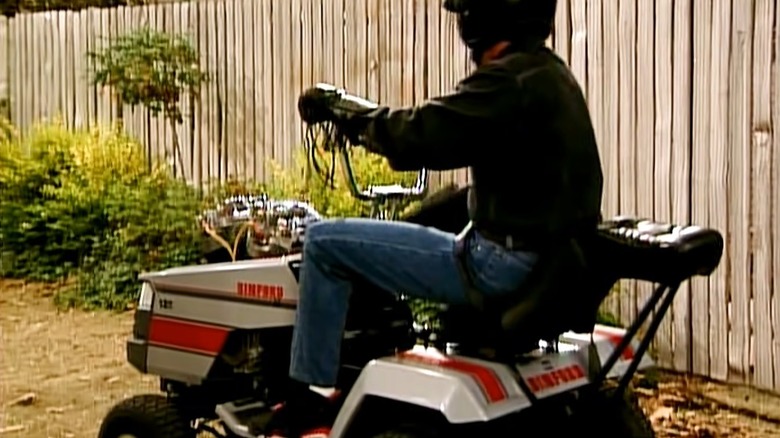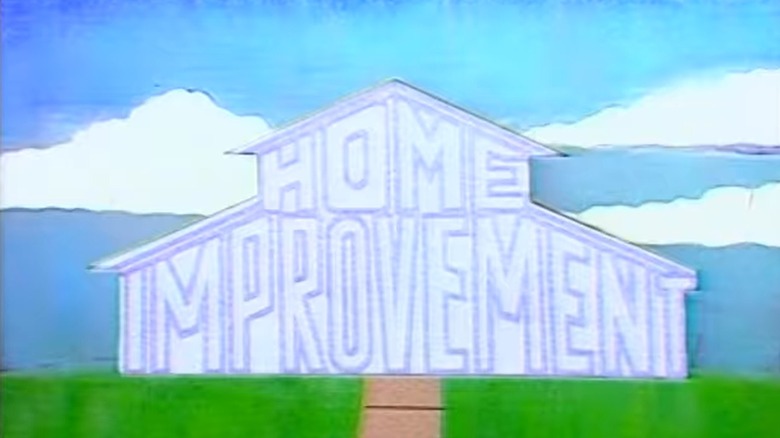What Home Improvement Got Completely Wrong About Renovating Your House
With "Home Improvement" returning to the universe of streaming (via TV Line), it's worth thinking about all the famous gags and bugaboos that took place in the series. Tim Allen portrays a bumbling home improvement TV personality, Tim Taylor, whose witty lines and less-than-impressive mastery of various tools in the show are always good for a laugh. Whether he's working alongside his cohost Al Borland or working on something at his own home, Taylor often finds himself outmatched by various tools or projects.
"Home Improvement" was an immensely funny television program, but the show itself should virtually never be used as inspiration for your own home improvement projects. Taylor often made use of questionable safety practices, broke many items on the set of his fictional, in-universe show, "Tool Time," and often injured himself or his compatriots in the process of his various antics. "Home Improvement" gets a lot of things wrong when it comes to the process of actual home improvement. Here are some of the top things that you should be mindful of when watching the show as a homeowner who may engage in some of these questionable practices yourself from time to time. Whether it be safety standards or the proper use of a specific tool that is sitting in your garage, keeping an eye on these features can help you gain greater enjoyment from the show and protect yourself and your loved ones in real life.
Working with live electricity
Tim Taylor often shocks himself well working on electrical outlets, appliances, light fixtures, and many other components of his home and the studio set where he works throughout the show's run. Working with electrical equipment and systems can be a dangerous endeavor. NES Fircroft notes that you should never work on live electrical wires when performing home improvement or maintenance tasks. This is because electrical shocks can be harmful or even deadly, and it's often difficult to tell just by sight how powerful an electrical shock might be if you were to touch the wrong wire or accidentally electrocute yourself in some way. Most electrical systems are reported in voltage, but the amps produced by an electrical circuit is the feature that can prove fatal, according to Let's Talk Science (although both measurements play a role in creating hazards in this regard).
Tim Allen's character in "Home Improvement" consistently works with live electricity and doesn't take essential safety precautions while doing so. This is obviously a TV show, and Allen is never actually injured by his character's lackadaisical safety record. The example should serve as a reminder for anyone conducting their own home improvement projects. Everyday Home Repairs and Home Questions Answered each note the value of an electrician's screwdriver set. These screwdrivers are grounded and will help prevent injury in the event of an electrical accident.
Conducting roof maintenance without safety equipment
Another common theme in "Home Improvement" is Tim Taylor's penchant for falling off of roofs and other high places. It seems that another gag established by the production team has Taylor strung up in a makeshift rope harness anytime he is working on something that can't be reached from the ground. Then, he inevitably falls off of the raised surface and hangs on the other side of a window or next to other cast members, consistently evoking laughs from the audience.
The truth is, working on projects that are hard to reach from the ground brings about a safety concern that must be met with caution and care. Generally speaking, a rope harness like the one used in the show would either fail as your body plummets toward the ground, providing no significant relief from the impact, or tighten up tremendously around your body like a snake as the tension becomes increasingly large. Either way, you're likely to suffer injuries from this kind of tumble off of a roof.
Safety Culture reports that a number of specific hazards should be policed when working on a roof, chief among them being hazards that may induce a slip. Wearing a hard hat and nonslip footwear, as well as taking note of any specific weather conditions or potential hazards caused by the vibration or movement of tools while engaged in the job at hand are important steps to ensuring your safety while working on the roof.
Not securing work surfaces when using power tools
Another key problem to be on the lookout for when taking inspiration from "Home Improvement" is the unsafe use of power tools. Power tools are an important addition to any homeowner's shed or garage. An impact driver, drill, or circular saw can make quick work of common fastening or cutting tasks. However, whether using a router or saw, Tim Taylor often fails to secure the work surface and maintain control over the cutting tool in question. In the show, this leads to admittedly funny bouts of physical comedy, but in real life, this could spell disaster for your hands, fingers, or other body parts, or may damage your work materials.
Handymom notes many of the key features of a circular saw, including the proper way to fit a new blade, how to effectively use the guard, and how to hold your circular saw for efficient cutting and essential safety. Maintaining safe use of your power tools will ensure that you never cut through something that you want to stay attached (for instance, a piece of your workbench, or even a finger!).
This is something that often eludes Tim Allen's character in the show, but taking great care to ensure that you aren't cutting or drilling without caution and focus can help make your experience in home improvement far more rewarding while minimizing the potential for damage or injury.
Utilizing unsafe demolition practices
On "Home Improvement," demolition is another key area that is played for laughs but occurs in a dramatically different setting when done in real life. Dumpsters notes that demolition often requires local authorization. Applying for the appropriate permit from your city or county offices is one of the first things you'll need to do when dismantling a section of your property to complete rebuilding and other renovations. It's also important to develop a plan of attack for your demolition project. Many interior walls can be removed without much issue, but certain segments of these walls, and some walls in their entirety, are load-bearing and therefore cannot be taken down without proper safety measures being put into place to ensure that the home itself doesn't fall apart.
Home improvement shows and this television sitcom of the same name often gloss over the demolition process and valorize the use of sledgehammers and deconstruction. In reality, this is a highly technical process that involves careful planning and execution and shouldn't be undertaken lightly.
Hughes & Salvidge reports that demolition done on older homes must include caution surrounding any leftover asbestos that may be lurking in the walls or ceiling. Asbestos is an incredibly harmful substance that must be dealt with before any general demolition can take place. If your home is found to contain asbestos, a licensed professional will need to take up involvement in the project in order to ensure the safety of the work team and your continued health and wellness in the property after the renovation has been finished.
Tim Taylor also shoots an alarming number of characters with a nailer
One of the other common aspects of physical comedy that takes place in "Home Improvement" is the use of a nail gun in alarming and truly unsafe ways. Nailers are used in a variety of different construction efforts, and they can make quick work of many framing and building tasks.
However, nail guns use pneumatic pressure to rapidly fire nails into wood or other surfaces. It is possible to repurpose this tool as a makeshift projectile launcher and this is exactly what happens throughout the run of "Home Improvement." Tim Taylor consistently misuses nail guns, randomly destroying objects in the shop or breaking windows. Occasionally, some of the characters are shot with nails and this provides a bit of comedic face-making.
In reality, OSHA notes that nail guns alone are responsible for roughly 37,000 trips to emergency rooms across the United States every year. This is because the nails travel at high velocity in order to secure themselves in the intended material target; and, unlike with the use of a hammer, a nail gun can apply this momentum without being held against the contact surface. Simply put, it's easy to strike your fingers with a hammer but difficult to drive a nail through one, but it's incredibly easy to nail your hand or finger with a nailer, and OSHA reports that more than half of injuries with this tool occur in hands and fingers.
Hydraulics hijinks
Hydraulic tools in general appear to be a broad issue for the cast of "Home Improvement." From Tim Taylor's lawnmowers to the improper use of lifting equipment and nailers, "Home Improvement" gets hydraulic equipment wrong on a startlingly high volume of occasions.
ID System reports that with any pressurized workplace tool, using safety equipment (eye protection, a helmet, gloves, and work boots, for instance) should be your first priority. Tools that make use of intense hydraulic pressure often incorporate their own integrated safety features, but these won't always protect you in every instance. OSHA notes that a roofer in 2007 died when he slipped and his nail gun came into contact with his head, unleashing a nail directly into his skull even as the safety features remained fully functional on the tool.
Hydraulic tools apply immense force in order to get difficult jobs done with ease. Generally speaking, the more force a tool applies, the more devastating an unintended consequence can be. A large blade will make a more substantial cut in the same amount of time as a small blade and a heavier hammer will inflict a greater crushing force than a small one. Worlifts notes that when performing maintenance on hydraulic lifting systems, the fluid can be incredibly hot and therefore immensely dangerous. Similarly, you should never trust the hydraulic system when standing underneath a lifted platform or any other component of the tool or vehicle. Blocking heavy platforms and other segments that you'll be working underneath is an essential step in ensuring the safety of yourself and your team.
Concrete mishaps are typical, too
Tim Taylor often seems to lay out a concrete slab only to have one of the other cast members (or himself in some instances) walk through the workspace before the concrete has cured and dried. Pouring a concrete slab is a highly technical process, even if it might not seem that way at face value. Mike Day Concrete reports that the first step in building a concrete slab is leveling and framing.
Building a timber frame around the area where you intend to pour out your concrete will give it the ultimate structure that is required to build a finished slab. Similarly, it's crucial to level the ground that will sit beneath your slab. Taking these two tasks in tandem will give you a quality starting point to work from once you're ready to begin pouring the concrete itself.
Leveling the tops of each board used to create the framework will then allow you to lay out a subtle gradient that will promote water runoff while ensuring a flat surface that you can build on or use for any other purpose.
After pouring the concrete, use a strike-off (a long, flat piece of wood or a job-specific tool) to level out the concrete, then run a trowel or float across the surface until it is smooth (via Copes and Gravel). It's also important to note that concrete slabs (for instance a newly poured driveway) won't ever fully cure, but it will take roughly 28 days for the surface to harden off enough for you to safely park a car on the slab without damaging its structure, according to The Concrete Network.
Lawnmowers: the more outrageous, the better
One interesting and quirky feature of the character Tim Taylor is his fascination with outrageous lawnmowers. The iconic character can't help himself when it comes to boosting power or increasing the style and drivability of an otherwise standard seated lawn mower. Lawnmowers are an important power tool that homeowners across the United States rely on, of course. During the summer months, you'll often need to mow your lawn once per week to keep up with the fast growth rate of the grass. And later on, during the winter, you may not need to mow your lawn at all. A fan of "Home Improvement" might get some interesting ideas about what to do with the lawn mower during this period of dormancy. However, it's important to remember that your lawn mower is not only an essential piece of equipment, but it also includes a potentially injury-inducing blade and a combustion engine that sits generally unguarded on the front of the equipment.
OrthoInfo reports that more than 253,000 people experienced injuries relating to lawn mower use in 2017 that required a visit to the doctor or a hospital. OrthoInfo notes that debris being thrown from underneath the lawn mower deck can travel at over 100 mph, and scrap pieces of metal or wood can cause severe injury to the mower or an onlooker while traveling at this pace. Similarly, even though the blade remains fixed at the bottom of the mower, it is certainly possible that misuse of the machinery can result in direct injury from the blade itself.
Tim Taylor isn't a particularly careful practitioner of home improvement techniques in any regard, and his interest in lawnmowers could result in some dramatic workplace injuries if translated into the real world.
At the end of the day, Home Improvement offers some wonderful entertainment
It should be noted, however, that "Home Improvement" is a TV sitcom and not a DIY home improvement show in the sense that they have cropped up in recent years: "This Old House," "Fixer Upper," and more showcase some of the actual techniques that are utilized in the home improvement industry, but they do so in an environment that prizes safety and proper workflow. "Home Improvement" is played for laughs, and Tim Allen's Tim Taylor is meant to be somewhat of a buffoon when it comes to home improvement know-how and craftsmanship.
At the end of the day, the show is all about entertaining an audience rather than providing inspiration for actual home improvement projects or a guide for how a homeowner might accomplish them.
Nostalgia Central reports that the show was originally loosely based on Tim Allen's standup comedy routines, in a similar fashion to the way that "Seinfeld" episodes often started or ended with a standup segment delivered by Jerry Seinfeld that roughly translated into a loose inspiration bit for the episode itself. Taken through this lens, it's clear that both "Home Improvement" and the fictional "Tool Time" show that Allen's character hosted were satirizations of this aspect of life. Nostalgia Central notes that Tim Taylor's cohost, Al Borland – played by Richard Karn – was usually far more knowledgeable than Taylor himself on any given topic that the two were presenting.
All this can be neatly wrapped up as a program of comedic genesis for Allen as a TV actor and his costars. The show was immensely popular in its day, and remains a wonderful look back into old TV sitcom programming; it just might not be a great resource for those looking to manage their home!

